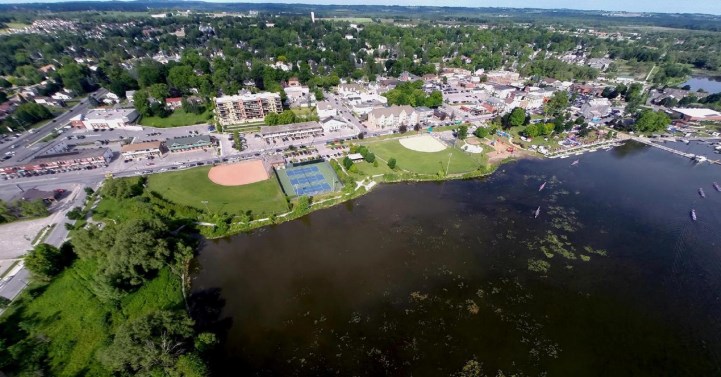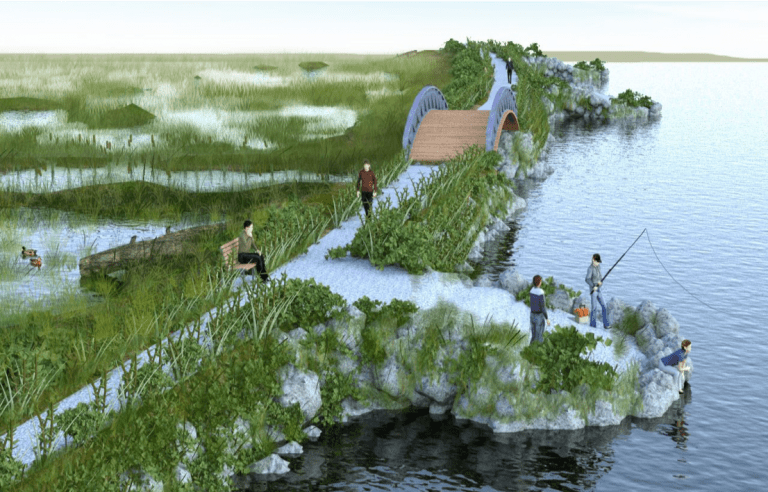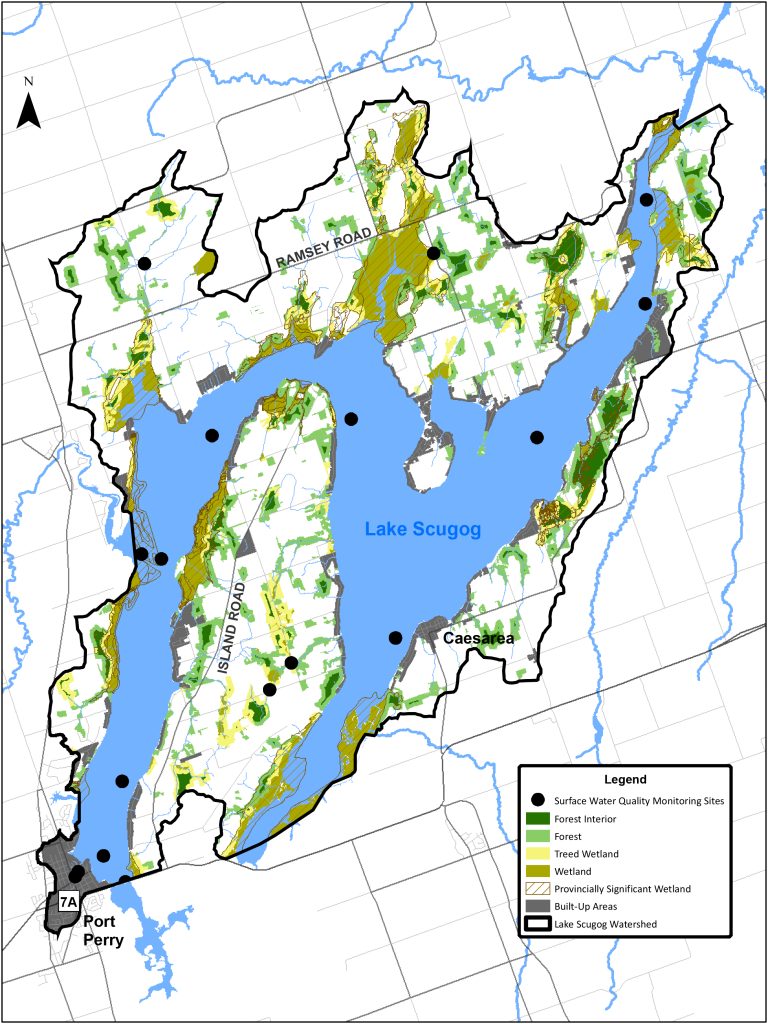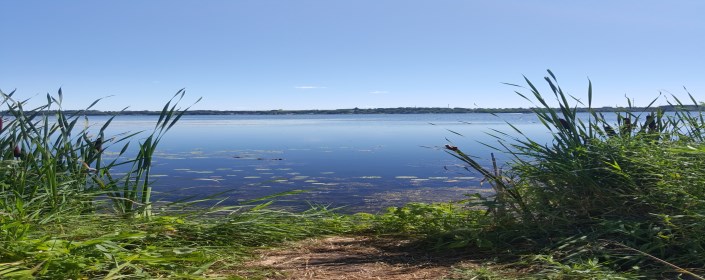Major environmental project to clean up Port Perry Bay on Lake Scugog to begin this fall
Published August 12, 2022 at 10:36 am

An ambitious project nearly a decade in the making to clean up Lake Scugog’s Port Perry Bay is just a few federal signatures (and a bit more local fundraising) away from shovels in the ground; or in the water, to be precise.
The Lake Scugog Enhancement Project is an environmental improvement and dredging project for Port Perry Bay that aims to create an engineered wetland that will remove excessive sediment and organic matter, manage invasive aquatic vegetation and return the bay to a navigation depth of 1.8 metres.
The lead on the project is the Township of Scugog but it has several key partners doing a lot of the work, including Scugog Lake Stewards Inc. and its president, Rob Messervey. Both have been has involved since the Township established the Healthy Lake Scugog Steering Committee in 2013 to research short and long term solutions for the health of the lake to increase tourism and recreational opportunities.
Messervey, who was with Kawartha Conservation at the time (another partner), said the scope of the $5.5 million project hasn’t changed much since they started taking muck samples for analysis in 2015. What has changed is the money raised locally and through various levels of government that has organizers expecting the initial construction can get underway this fall.

“We asked the Region of Durham for $60,000 for a consultant back then. They gave it to us but said ‘don’t come back or all the conservation groups will be asking for money,’” he remembered. “Since then there have been design changes, modified designs and refinements to the design and many public consultations.”
“But it’s essentially the same project.”
The plan is to create the wetland (contained by a 245-metre engineered berm that will have a three metre wide accessible path, park benches and angling platforms) – that will improve the quality and diversity of fish, amphibian, reptile and waterfowl habitats and tourism/ recreation opportunities through an extension of the waterfront trail.
The project will mitigate stormwater inputs with the installation of three oil and grit separators, which will be the first item on the construction agenda this fall, Messervey said.
“We’re just waiting for the final approvals from the federal agencies,” he said, noting that Ottawa technically owns the lakebed.
Those agencies include Parks Canada, Transport Canada and the Ministry of Fisheries and Oceans, who have asked for a letter of credit – there are ten different walleye spawning grounds in the area – to compensate the government for any possible loss of fish habitat.

The wetland itself will be 14,900 square metres – created, in part by the muck taken from the bottom of the bay – in the southwest corner of the lake, near the Water Street tennis courts and ball diamonds, and will feature basking logs, vegetated hummocks, nesting features, seed mixes and native shrubs. There will also be two stone-cored wet meadows created and a 12-metre wide channel dredged to help the flow of water into the lake ands to convey flow into Lake Scugog.
There will be nine dredge areas in all, totalling 4.13 hectares.
One of the very interested parties in the project is the Mississaugas of Scugog Island First Nation, whose land is near the other end of the bay. The First Nation was the first to provide funding (after the regional consulting fee) when they gave $200,000 to the project and they have recently awarded $1.5 million to the cause: the largest donation – including governments – the Lake Scugog Enhancement Project has received.
Messervey said the approval of MSIFN was necessary and the funding they have provided has been “very valuable and very significant.”
Chief Kelly LaRocca said the First Nation was eager to help fund what she called a “much needed” project.
“The MSIFN welcomes this opportunity to work with the Township of Scugog and look forward to approval of funding and favourable successful completion for this much needed community project which will support First Nation recreational, social, economic and tourism needs.”
Messervey said the community as a whole has been very supportive and the lake users – the dragon boat club, sport fishing organizations, the local rowing club, naturalists and environmentalists have all come out in support of the project.

The 2018 Township Strategic Planning Survey, in fact, found that 91 per cent of respondents were in support of the project.
In addition to the First Nation contribution of $1.7 million, Durham Region has donated $1.2 million, Ottawa has kicked in $700,000 through a grant and Scugog and Queen’s Park have each contributed $100,000, leaving a shortfall of $700,000.
Considering the Port Perry waterfront is arguably the most visited and iconic location in the entire township and that the Scugog watershed is a natural asset of significant value estimated to be more than $300 million a year, Messervey is hopeful the goal will be reached this fall.
Messervey said they are in the process of applying for additional government grant funding and community fundraising should take care of the rest.
Ontario Tech University researcher Dr. Andrea Kirkwood, a professor in the Faculty of Science at Ontario Tech University with special expertise in environmental microbiology and aquatic ecosystems, regularly takes students to Lake Scugog for research projects and “fully supports” the project.
She says the idea of the project is to construct a “bio-filter wetland” to remove contaminated sediments before they reach the lake.
The bay receives a lot of unwanted run-off in the form of road salt, contaminated fertilizer and sewage overflow and has done so for decades or more, she explained. “Sedimentation is a natural process but the water has to go somewhere. Now, when the water reaches Port Perry Bay and the lake itself it will be a lot cleaner. This can only help the ecological value of the lake.”

“Scugog is a very productive lake with a very important fishery but it’s also a stressed-out lake,” said Kirkwood, is actively involved in several community-based environmental stewardship initiatives. “The people who live there know.”
Once the three oil and grit separators are built this fall – pending those pesky federal approvals – Messervey said rest of the project, including the berm and the wetland and its amenities can begin in earnest in the spring. Completion date is expected sometime in 2024.
“We are constrained by timing windows related to spawning seasons, reptile migrations etc. that dictate when we can work in the water and when we can’t but 2024 is our hope,” he said. “It’s going to take a year or more for the wetland to stabilize.”
While that’s happening the project team will be busy doing other things, such as building habitat for reptiles, as well as basking and nesting areas.
“There’s still some work to do.”
The Township has been preparing for the project for many years and has worked to improve stormwater management; insisting on stormwater pond installations in new subdivisions and commercial areas, promoting rain gardens, installing stormceptors and filter bags in storm drains. This new work, according to outgoing Mayor Bobbie Drew, will give the bay a fighting chance to have those measures work for the future.
“The lake is so important to our community and this environmental project (will) … improve the health of Lake Scugog,” she said. “A healthy lake means a healthy community.”







